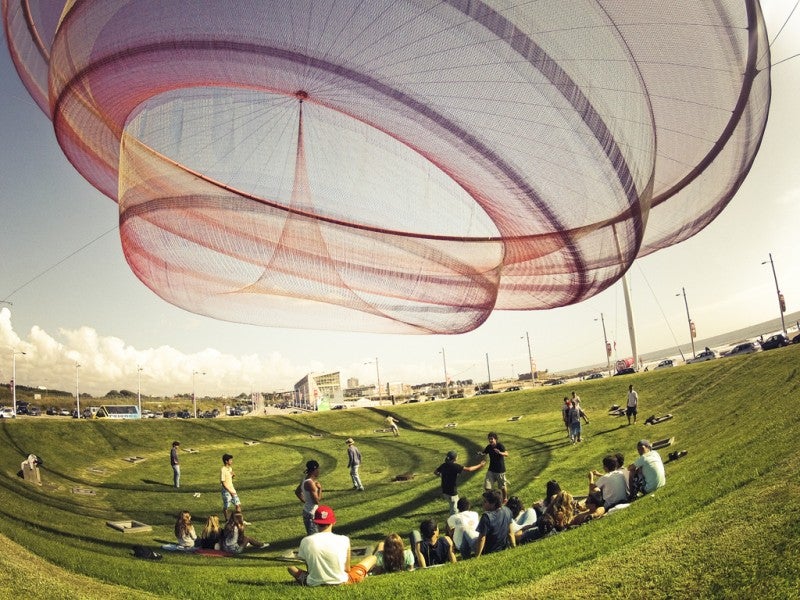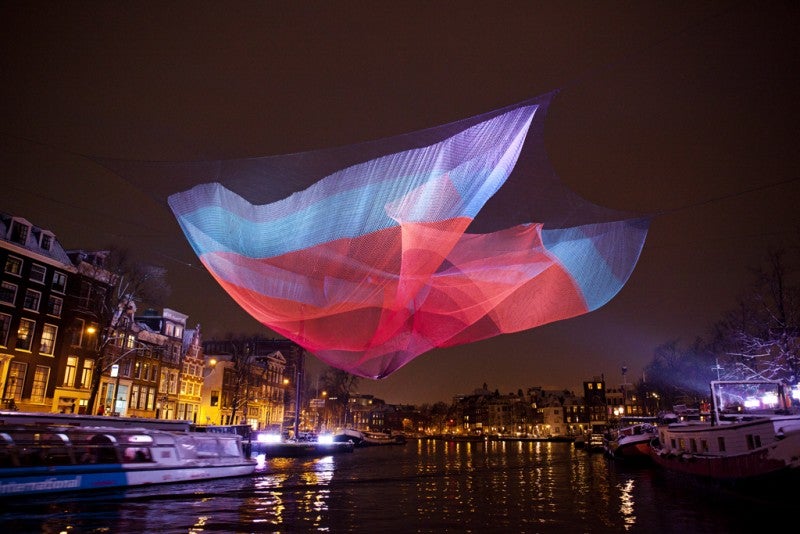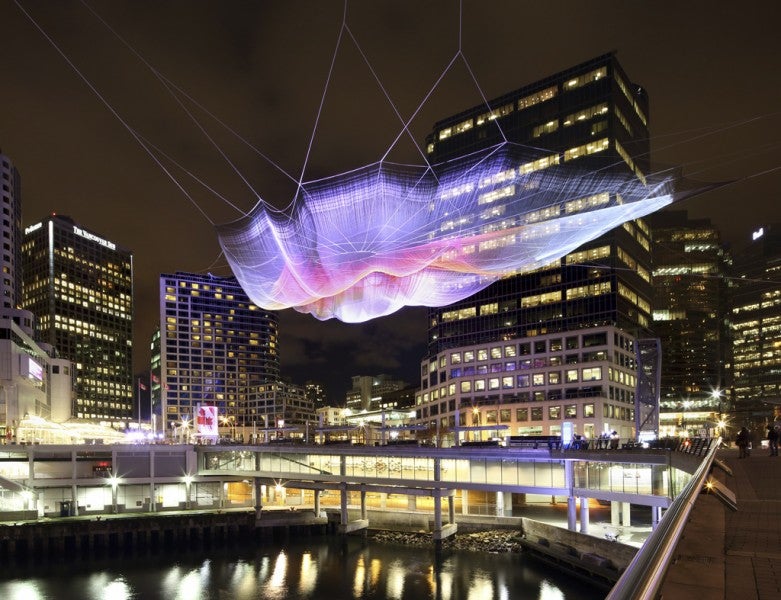
“She Changes” by Janet Echelman
Last night, Henry Crown Fellow and internationally-recognized sculptor Janet Echelman was honored with the Smithsonian Institution’s American Ingenuity Award for Visual Art during a special event at the National Portrait Gallery in Washington, DC. Selected for their extraordinary creativity and innovative work, Echelman and the nine other honorees were chosen from the fields of education, technology, historical scholarship, natural sciences, social progress, physical sciences, youth, and performing arts.
Echelman’s sculptures combine cutting-edge design with ancient materials. They occupy public spaces all over the world, from the waterfront of Porto, Portugal, to San Francisco Airport’s Terminal Two. Michael Caruso, the Smithsonian magazine’s editor-in-chief described Echelman’s sculptures, saying, “Her net sculptures dominate large spaces, and yet they seem so ethereal. They’re based on knots — an ancient technology—and yet her computer-aided designs allow for stunning feats of expression and interaction.”
On the eve of her recognition by the Smithsonian, we spoke with Echelman about the creative process, how a visit to a Tamil fishing village transformed her as an artist, and how she has seen her work transform public spaces.
Aspen Idea: Many of your sculptures are large-scale installations. What is the process of conceptualizing a work of art for an urban space like?
Janet Echelman: Each work is a discovery for me. I begin with research to learn about the place, interviewing the people, researching history, geography, material anthropology. Ideas emerge; I sketch them in the studio, and begin to develop their forms in relation to the site using our custom computer modeling software. We also make a lot of physical hand-models.
I note that when I feel stuck, it’s often when I’ve relied too heavily on our computer models. Sometimes the physical discovery of tracing wire and string on our tabletop models helps us break free.
New challenges keep my experience as an artist fresh. That also means it’s difficult, and I’m never sure how I’ll find my way through. But somehow we do.

Sculpture Project at the Amsterdam Light Festival by Janet Echelman
AI: Your technique of using nets to create your pieces is so unique. Tell us about how you began working with that material.
JE: I started out as a painter. After a decade, I applied for a Fulbright to teach painting in India and present exhibitions there. I shipped my paints and special tools. The deadline for the show arrived, but my paints did not. I realized I could either hit my head against a wall about what wasn’t there, or take on the challenge to embrace what was there.
I was in Mahabalipuram, a Tamil fishing village famous for bronze and stone sculpture for a thousand years. So I apprenticed to the local bronze caster, but quickly realized bronze was too heavy and expensive. Walking along the beach, I saw the fishermen bundling their nets into mounds on the sand. I’d seen it every day, but this time I saw it differently — a new approach to sculpture, a way to make volumetric form without heavy solid materials.
AI: Some of your pieces are indoors and many are outdoors. How have you been able to incorporate natural elements like wind, water, and light in the outdoor installations?
JE: Because my aerial sculptures are made entirely of soft materials, they’re ultra lightweight and can attach to existing architecture without extra reinforcement. The soft surfaces are animated by the wind, creating fluidly moving forms that ripple in ever-changing patterns.
Collaboration is what makes my outdoor work possible — especially with engineers. My sculptures must withstand hurricane force winds of 90 mph, and permanent works must resist UV exposure, snow, and ice storms.

“Skies Painted with Unnumbered Sparks” by Janet Echelman
AI: What do you see as the “next big thing” in urban art? What will we be seeing more of in the next 10 years?
JE: I do see interactivity as something that will become more natural and seamless, and we are experimenting with physical and digital ways for people to co-create the artwork with me.
I’m working with my team to create the lightest possible forms at a scale that can lace into skyscrapers, which help mediate the scale of industrial production down to the human hand with a feel of hand-crafted lace.
AI: Can you share a story of how you have seen one of your works change a public space?
JE: I recently discovered through Flickr photos that my sculpture She Changes in Portugal — which is suspended above a three-lane highway roundabout with no crosswalk — has become a gathering place for people underneath it. We’re always trying to attract people to places, and when a place designed to keep them away still draws people in, this tells me something special is happening.
AI: Which sculpture are you most proud of? Why?
JE: That’s tough — I’ll probably always pick the most current challenge. This year we installed my most challenging project to date in the middle of an active city — Skies Painted with Unnumbered Sparks, which opened with the TED Conference’s 30th anniversary in Vancouver. It spanned 745 feet between rooftops across city streets, pedestrian plaza, and water, laced directly into existing buildings with no extra structure, and invited the public to paint it with light in real time by tracing gestures on their mobile devices. But one of the most moving experiences of my life was just spending time with it one quiet evening as it billowed in the wind. Somehow it made me feel my grandmother’s presence. A woman who was staying in a hotel room that faced the sculpture came up to me and explained that her husband was undergoing treatment for cancer, and that looking at the sculpture made her feel protected.
Caitlin Colegrove is the network and communications manager for the Aspen Global Leadership Network.

